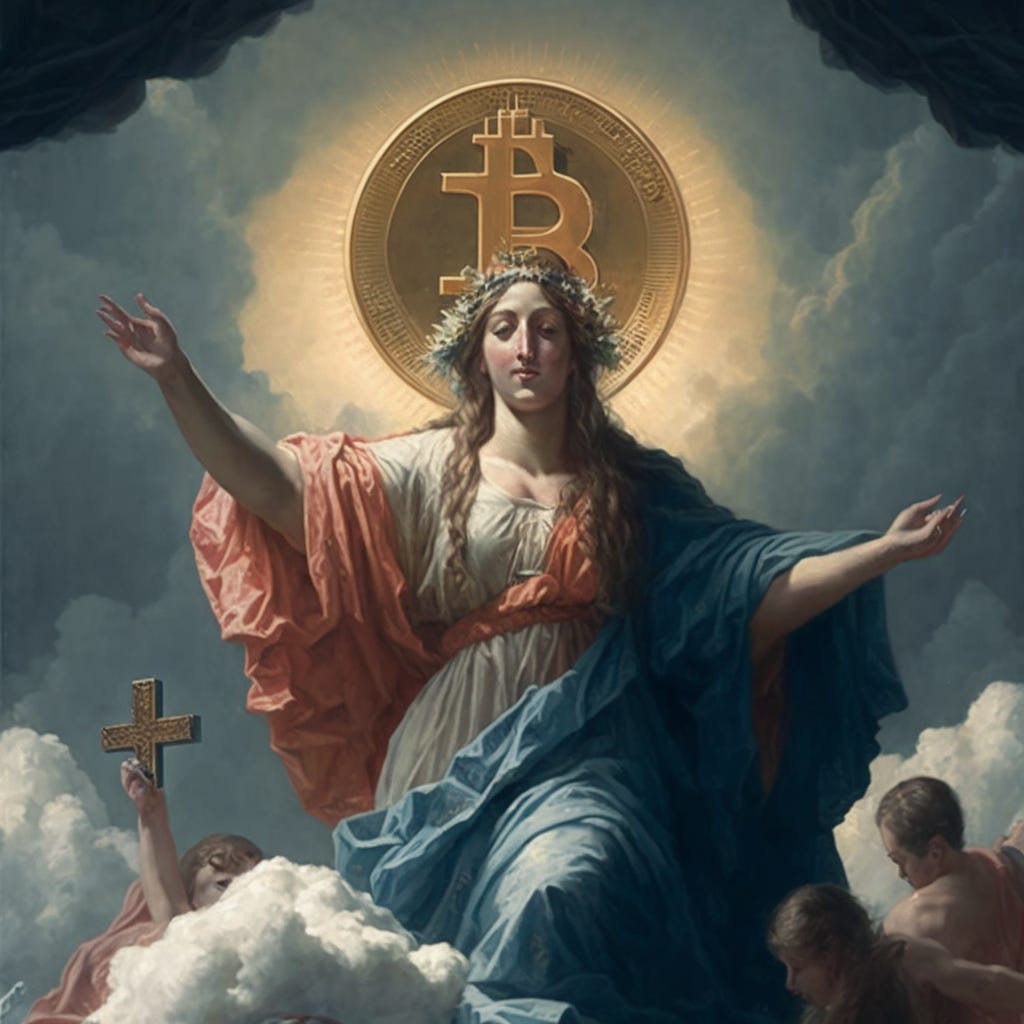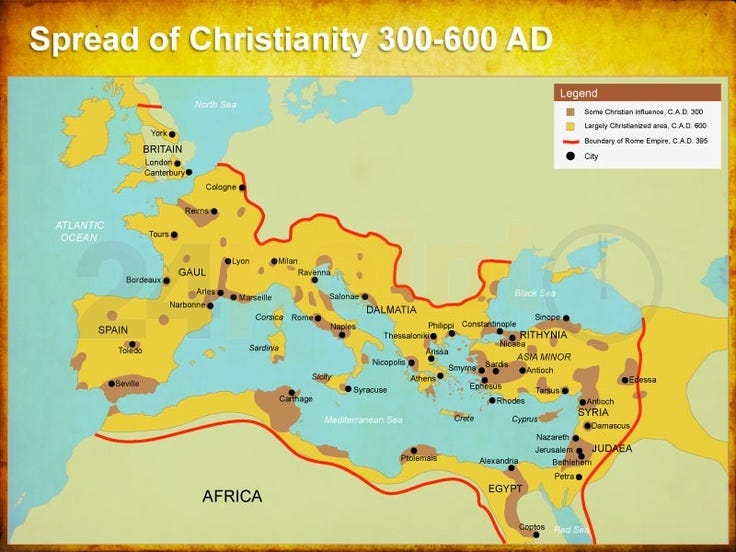The First Decentralized Body
@FractalBounce: Jan 19, 2024

In the cyclical view of history, the parallels between the origin and diffusion of Bitcoin and the rise of Christianity, particularly in the establishment of its early decentralized Church structure, unveil a fascinating narrative. The idea is that Bitcoin’s structure along with its rise and dissemination parallel the historical path of Christianity, establishing links not just in their mysterious beginnings but also in their collective reaction to perceived oppression, whether in the financial sphere or the realm of spiritual beliefs. Both narratives unfold as counterforces to prevailing powers, encountering resistance from established authorities and governmental entities. The founders of both Bitcoin and Christianity operated in the shadows, maintaining minimal contact with select groups before mysteriously disappearing, leaving behind legacies that would shape the course of history. Furthermore, the spread of these transformative forces is marked by the establishment of new nodes or churches, where the authenticity of the proclaimed “truth” is verified, contributing to the decentralization of their influence. Significantly, in their original forms, both Bitcoin and the early Christian Church lacked a centralized governance structure, fostering a decentralized ethos that defined their initial movements. This exploration aims to delve into these striking similarities, unraveling a narrative that transcends temporal boundaries and exposes the cyclical patterns woven into the fabric of human history.
The philosophical foundations of both Christianity and Bitcoin are deeply rooted in addressing fundamental human needs and challenging existing power structures. In the case of Christianity, its emergence can be seen as a response to the spiritual and moral needs of individuals who found themselves subject to a system where spiritual knowledge was centralized and controlled by established authorities, often intertwined with the government. Jesus, in his teachings, offered a direct and personal approach to God, circumventing intermediaries and removing a layer of corruption associated with the manipulation of spiritual knowledge. This resonated with a desire for a more direct connection to divinity and a rejection of centralized control over matters of faith.
Similarly, Bitcoin’s philosophical foundations arise from a response to financial and economic needs, where the global market is controlled by central banks and financial institutions. The traditional monetary system, governed by a select few, has led to concerns about transparency, manipulation, and inequality. In proposing an alternative decentralized system, Satoshi Nakamoto sought to challenge this centralized control. Bitcoin, with its peer-to-peer nature, offers a direct approach to value and money, eliminating intermediaries and reducing the potential for corruption within the financial system. Both Christianity and Bitcoin share a common thread in advocating for a more direct and transparent relationship with core aspects of human existence—spirituality and finance—by challenging the intermediary structures that had come to dominate these spheres.

The Spread Of Christianity
The theme of resistance to established powers binds the narratives of both Christianity and Bitcoin, reflecting a recurrent pattern in historical struggles against tyranny. Early Christianity faced intense persecution from the Roman Empire, as the new faith challenged the established religious and political order. Similarly, Bitcoin has encountered skepticism and resistance from traditional financial institutions and governments, which view it as a disruptive force to the existing monetary order. Yet, historical cycles often exhibit a transformation in the relationship between disruptive movements and established powers. Christianity, once persecuted, eventually gained acceptance and became the official religion of the Roman Empire. A parallel can be drawn in the contemporary context with Bitcoin’s trajectory, as regulatory attitudes shift, and recent approvals of Bitcoin Exchange-Traded Funds (ETFs) in the United States signal a potential shift in institutional acceptance. This echoes a cyclical pattern where resistance gives way to acceptance, prompting exploration into the idea that Bitcoin’s evolution may mirror the historical acceptance trajectory of the early Christian Church, marking a transformative journey from opposition to integration within established systems. This concept will be further examined as we delve into modeling Bitcoin adoption based on the developmental phases of the early Christian Church.
The concept of a decentralized structure resonates deeply in both the teachings of Jesus within Christianity and the foundational principles of Bitcoin. Jesus, as a spiritual leader, decentralized the understanding of spiritual wisdom by proclaiming that each person carries the “kingdom of God within.” This notion can be likened to the concept of a distributed network or blockchain, where the entire network is contained within each individual unit. The introduction of the Church by Jesus further exemplifies a commitment to a decentralized body, where the Church was envisioned as a living, breathing entity composed of numerous individuals rather than a centralized authority. This decentralized nature of the Church extends globally but manifests consensus through physical nodes, represented by church groups, where the authenticity of spiritual truth is verified collectively.

The parallel with Bitcoin becomes evident when considering its decentralized structure. Bitcoin operates on a global network of nodes, each containing a copy of the blockchain, reflecting the idea that the entire network is present within each participant. The process of reaching consensus in the Bitcoin network mirrors the dynamics of the early Christian Church, as both involve verification and validation of truth. In cases where consensus is not achieved, the concept of a fork or split occurs, mirroring the schism in the Church that led to separate paths. This decentralized model, whether applied to spiritual truth or financial systems, underscores a recurring theme in history where systems are designed to distribute power and decision-making across a network rather than concentrating authority in a central entity.
The driving force of evangelical fervor and the spread of a new idea serves as a remarkable commonality between the formation of early Christian communities and the emergence of Bitcoin communities. In the context of early Christianity, communities were forged by individuals united by a shared belief system, creating a sense of shared purpose and belonging. The early Christians actively engaged in missionary efforts, tirelessly sharing their faith, and converting others through the compelling appeal of their newfound beliefs. Similarly, the realm of Bitcoin is marked by communities formed around a shared interest in decentralized finance and a steadfast belief in the principles of cryptocurrency. Enthusiasts within the Bitcoin ecosystem passionately engage in evangelism, actively promoting the adoption of Bitcoin and educating others about the transformative potential of decentralized currencies.
The parallel becomes even more apparent when considering the methods employed for spreading these ideas. In the case of Christianity, missionary efforts were instrumental in carrying the message across regions and cultures. Likewise, Bitcoin spreads through evangelism, where individuals and communities actively participate in the dissemination of information, fostering a collective understanding of the benefits of cryptocurrency. The evangelical fervor that characterized the early Christian movement finds resonance in the enthusiastic promotion of Bitcoin as a disruptive force in the financial world. This shared characteristic illustrates a recurring pattern in history where transformative ideas, whether spiritual or financial, thrive through the impassioned advocacy and active participation of their adherents, creating communities that drive the widespread adoption of revolutionary concepts.
The outlined trajectory of the adoption of a new idea, drawing parallels between the spread of Christianity and the potential evolution of Bitcoin, provides a thought-provoking lens through which we can analyze the dynamics of transformative movements. The journey from the creation of a new idea to its acceptance is a recurring theme in history, seen in both spiritual and financial realms. Just as Christianity faced resistance in the form of mockery and persecution, Bitcoin has encountered skepticism and bans in its early stages. The realization that the idea is resilient and cannot be extinguished sets the stage for a shift in attitudes, leading to tolerance and eventual warming to the idea.
A crucial point in this journey is the acceptance and adoption by influential individuals in government or business, a phase where the idea gains credibility and attention from the ruling class. However, the subsequent attempts by the state to modify, centralize, and control the idea echo historical patterns of co-option by established powers. This evolution often results in a version of the idea that diverges from its original purpose. Dissidents, rebels, and non-conformists play a vital role in preserving the authentic version of the idea, reminding people of its original purpose and highlighting the deviations introduced by the state.
The conflict between the state’s version and the authentic idea may lead to a fork or schism, where the original concept reemerges in direct opposition to the state-controlled version. The struggle for authentication becomes a central theme, with centralization and government attempts to assert authority over the idea. This cyclic pattern reflects the ongoing tension between transformative ideas and the efforts of established powers to shape and control their narrative. In exploring this trajectory, we gain insights into the potential challenges and transformations that Bitcoin may undergo as it continues to shape the landscape of decentralized finance.
In tracing the parallels between the origin, spread, and evolution of Bitcoin and the historical trajectory of Christianity, a rich image of similarities emerges. Both narratives share enigmatic origins, stemming from a response to perceived tyranny within the monetary system and the realm of the spirit. The resistance faced by early Christianity from established authorities finds echoes in Bitcoin’s encounters with skepticism and bans. Moreover, the decentralized structures of the early Christian Church and Bitcoin underscore a commitment to distributing power and decision-making across a network, fostering a sense of autonomy. Evangelical fervor, inherent in the formation and spread of both communities, highlights the shared enthusiasm for spreading transformative ideas. The cyclical pattern of adoption, resistance, acceptance, and potential co-option by the state unfolds in both narratives, suggesting a recurring rhythm in history. As Bitcoin charts its course in the financial landscape, the historical lens offers insights into the challenges and transformations it may undergo, underscoring the resilience of ideas that resonate with the human quest for autonomy and decentralized frameworks. This exploration invites contemplation on the cyclical nature of transformative movements and the potential for decentralized ideas to shape the course of history.